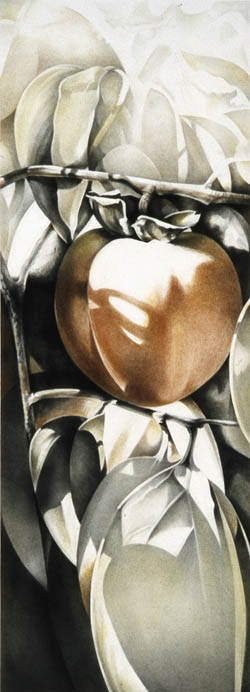Davis Birks: Strata and Susan Manchester: New and Recent Works on Paper. At Edward Cella Art+Architecture.
Spiral Center
Edward Cella has two compelling shows running concurrently this month, and both artists exhibit fully realized potential. For instance, it’s exhilarating to look for references in the art of Davis Birks-is that Agnes Martin, Robert Smithson, and Cy Twombly?-but after the initial, giddy rush of contact with such apparent visual intelligence wanes, a second aesthetic awareness of the artist’s firm conviction kicks in.

Birks’s objects aren’t always flat or conventional enough to wear the title “painting” easily. Some of his most ambitious works, like “Blackboard #10” and “Blackboard #11,” both from 2005, are probably technically paintings-they were done in permanent ink and acrylic on canvas and are shown behind Plexiglas. Others, such as “Carved Spiral #8” and “Carved Spiral #9,” while very similar in shape, manner, and scale to the “Blackboards,” were carved into large pieces of black Plexiglas. Whatever the material or the process, they absorb attention like big black-and-white brain sponges.
Birks lives in Puerto Vallarta and shows internationally. His work feels like it belongs in Santa Barbara. These meaningful and fully centered organic forms imply the center just might hold-as long as we remember to shake and shimmy with it for all we’re worth.
Susan Manchester has a career that spans continents and decades, yet her work somehow manages to be perfectly au courant. The California light in a Susan Manchester drawing is the one you saw 15 minutes ago, bleaching and emblazoning the wall outside your window at work. This show concentrates on an amazing series of still life pictures called the “Persimmon Tree Chronicles.” There’s a great balance here between color, perspective, and composition; Ikebana, the Japanese art of Zen-inspired floral arrangement, meets postmodern drawing. And the colors throughout are so subtle that one relearns to see color each time in order to get at them. Especially effective in this regard are the exquisite chiaroscuros in the pair of silverpoint drawings shown from the “Persimmon Suite.” Again, the connection to all that has come before, including much personal study of Italian art in situ, is revealed to the viewer both at once and over time, like the ripening of the fruit of experience.



